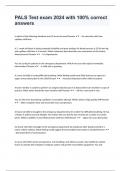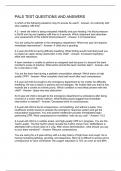Popular courses 'PALS' at PALS
PALS Study guides, Class notes & Summaries
Looking for the best study guides, study notes and summaries about PALS? On this page you'll find 2403 study documents about PALS.
All 2.403 results
Sort by
 Popular
Popular
-
PALS Test exam 2024 with 100% correct answers
- Exam (elaborations) • 8 pages • 2024
-
- $16.49
- 10x sold
- + learn more
In which of the following situations may IO access be used? Answer - An extremity with slow capillary refill time. A 2 - week old infant is being evaluated irritability and poor feeding. His blood pressure is 55/40 mm Hg and capillary refill time is 5 seconds. Which statement best describes your assessment of this infants blood pressure?Answer - It is Hypotensive You are caring for patients in the emergency department. Which two year old requires immediate interventions?Answer - A c...
 Popular
Popular
-
PALS TEST QUESTIONS AND ANSWERS
- Exam (elaborations) • 6 pages • 2023 Popular
-
- $10.79
- 8x sold
- + learn more
In which of the following situations may IO access be used? - Answer- An extremity with slow capillary refill time. A 2 - week old infant is being evaluated irritability and poor feeding. His blood pressure is 55/40 mm Hg and capillary refill time is 5 seconds. Which statement best describes your assessment of this infants blood pressure? - Answer- It is Hypotensive You are caring for patients in the emergency department. Which two year old requires immediate interventions? - Answer- A chi...

-
PALS Questions and Verified Answers | Passed | A+
- Exam (elaborations) • 10 pages • 2024
-
- $9.99
- + learn more
Ratio of compressions to ventilations for two rescuer CPR on infant or child? : 15:2 Pedi SBP HOTN formula for ages 1-10? : 70 + (2x age in years) Hypoglycemia infant? : <60 mg/dl Hypoglycemia Neonate? : <45 mg/dl HOTN SBP Infant? : 70 mm hg 2 HOTN SBP Neonate? : 60 mm hg Uncuffed tube size formula : Age in years / 4+4 Possible/Probable rate issue in infants : 220 bpm Possible/ Probable rate issue Child : 180 bpm PEDI Sync Cardioversion Dosage : First dose 0.5 - 1 J/KG....

-
PALS Questions and Verified Answers | Passed | A+
- Exam (elaborations) • 4 pages • 2024
-
- $9.99
- + learn more
Shock Energy for Defibrillation : First shock 2J/kg, second shock 4 J/kg, subsequent shocks >/=4 J/kg, maximum 10 J/kg or adult dose Epinephrine dosage for pulseless arrest and bradycardia : 0.01 mg/kg IV/IO (0.1 ml/kg of 1:10,000 concentration). Repeat every 3-5 mins. If no IV/IO access, may give ET dosage: 0.1 mg/kg (0.1 mL/kg of 1:1000 concentration). Amiodarone adminstration for SVT and VT with pulses : 5 mg/kg IV/IO load over 20-60 mins (max 300 mg), repeat to daily max of 15 mg...

-
PALS Questions and Verified Answers | Passed | A+
- Exam (elaborations) • 14 pages • 2024
-
- $10.49
- + learn more
compression to breath ratio children with 1 rescuer : 30:2 2 rescuer compression to breath ratio? : 15:2 Initial impression of a 2-year old girl shows her to be alert with mild breathing difficulty during inspiration and pale skin color. On primary assessment, she makes high pitched inspiratory sound (mild stridor) when agitated; otherwise, intercoastal retractions. Lung auscultation reveals transmitted upper airway sounds with adequate distal breath sounds bilaterally. Which is the ...

-
PALS FINAL RED CROSS Questions and Verified Answers | Passed | A+
- Exam (elaborations) • 13 pages • 2024
-
- $10.49
- + learn more
A 4-month old infant is brought to the emergency department in cardiac arrest. Which condition would the team identify as the most common cause of cardiac arrest in an infant of this age? : sudden infant death syndrome is the most common cause in infants younger than 6 months of age. The PALS resuscitation team is providing care to an intubated child in cardiac arrest. Which result best determines the adequacy of the team's chest compressions? : End-tidal carbon dioxide level between...

-
PALS Questions and Verified Answers | Passed | A+
- Exam (elaborations) • 81 pages • 2024
-
- $17.39
- + learn more
What should the first rescuer arriving on the scene of an unresponsive infant or child do? (Put the steps in order.) : 2,1,4,3 How long should assessing for breathing and a pulse take? : No longer than 10 seconds What should you do to check for breathing? : Look for chest rise and fall Where can you check a pulse on an infant and a child? : Brachial 2 If the child does not have normal breathing and a pulse of 64/min is present, you will need to : provide rescue breathing For an un...

-
PALS All Questions and Verified Answers | Passed | A
- Exam (elaborations) • 27 pages • 2024
-
- $12.49
- + learn more
You are caring for a child who was resuscitated after a drowning event. The child is intubated and ventilated with 100% oxygen with equal breath sounds and exhaled CO2 detected. The heart rate is slow and the monitor shows sinus bradycardia. The skin is cool, mottled, and moist; distal pulses are not palpable and the central pulses are weak. Intravenous access has been established. The core temperature is 37.3oC. Based on the PALS bradycardia algorithm, which of the following should be...

-
PALS Pretest Questions and Verified Answers | Passed | A+
- Exam (elaborations) • 9 pages • 2024
-
- $9.99
- + learn more
what should the first rescuer arriving on the scene of an unresponsive infant or child do? : verify scene safety, check responsiveness, shout for help, activate emergency response system How long should assessing for breathing and checking for a pulse take? : No longer than 10 seconds If the AED indicates no shock advised, what should be the next action? : Start chest compressions What is the compression-to-breath ratio for 1- and 2-rescuer CPR for children and infants? : 1-rescuer, 30:...

-
PALS Version A Questions & Answers | 100% Correct Answers | Verified | Latest 2024 Version
- Exam (elaborations) • 8 pages • 2024
-
- $12.99
- + learn more
You are caring for a child who was resuscitated after a drowning event. The child is intubated and ventilated with 100% oxygen with equal breath sounds and exhaled CO₂ detected. The heart rate is slow and the monitor shows sinus bradycardia. The skin is cool, mottled, and moist; distal pulses are not palpable and the central pulses are weak. Intravenous access has been established. The core temperature is 37.3°C. Based on the PALS bradycardia algorithm, which of the following should be p...

-
PALS Version A Questions | 100% Correct Answers | Verified | Latest 2024 Version
- Exam (elaborations) • 8 pages • 2024
-
- $10.99
- + learn more
You are caring for a child who was resuscitated after a drowning event. The child is intubated and ventilated with 100% oxygen with equal breath sounds and exhaled CO2 detected. The heart rate is slow and the monitor shows sinus bradycardia. The skin is cool, mottled, and moist; distal pulses are not palpable and the central pulses are weak. Intravenous access has been established. The core temperature is 37.3oC. Based on the PALS bradycardia algorithm, which of the following should be prov...

-
PALS Questions and Verified Answers | Passed | A+
- Exam (elaborations) • 81 pages • 2024
-
- $17.09
- + learn more
What should the first rescuer arriving on the scene of an unresponsive infant or child do? (Put the steps in order.) : 2,1,4,3 How long should assessing for breathing and a pulse take? : No longer than 10 seconds What should you do to check for breathing? : Look for chest rise and fall Where can you check a pulse on an infant and a child? : Brachial 2 If the child does not have normal breathing and a pulse of 64/min is present, you will need to : provide rescue breathing For an un...

$6.50 for your textbook summary multiplied by 100 fellow students... Do the math: that's a lot of money! Don't be a thief of your own wallet and start uploading yours now. Discover all about earning on Stuvia


